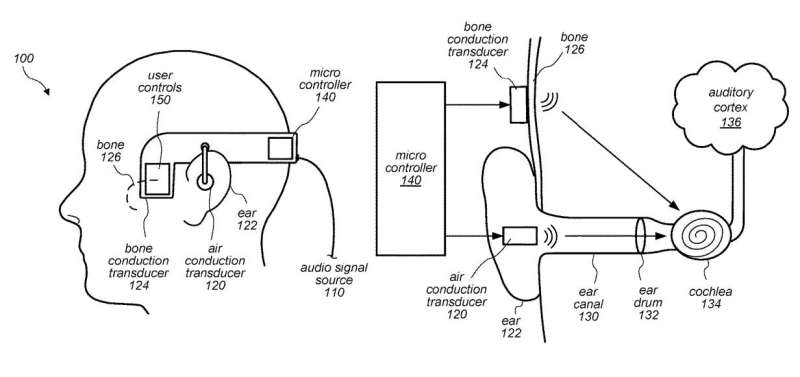July 31, 2020 report
Will next AirPods feature bone conduction?

Will Apple's next big air bud project be called iBone?
Maybe not, but the folks at Cupertino are exploring a new approach to its AirPod line of earpieces.
A patent was granted to Apple on Tuesday for a design that would use bone conduction to transmit sounds instead of a traditional ear piece placed in the ear.
With bone conduction, the user wears a device that transmits vibrations through the skull directly to the cochlea, the inner ear structure than converts vibrations to neural signals that our brains interpret as sounds. The device is held by a band wrapped behind the head. This leaves the ears free and is helpful when the user requires minimal interference with hearing ambient sounds.
It allows for ear bud functionality in environments where regular ear buds would not function, such as under water. And it is more convenient for joggers, for instance, who should find more stability with firmly placed bone-conduction devices than with less stable ear buds that can easily fall out when running.
There currently are a few ear buds based on bone conduction on the market, such as the AfterShokz Aeropex and Pyle PSWBT550.
Some critics say the sound quality of bone conduction ear pieces is inferior to standard ones. This is largely due to bone conduction's poor handling of high frequency sounds. The technology works best with sounds in the 4,000 Hz level and below, while sounds spanning 4,000 Hz to 20,000 Hz are better handled by traditional air bud transmission called air induction.
Apple's patent, titled "Multipath audio stimulation using audio compressors," addresses this problem by relying on two transmission methods. One component of what may eventually become the AirPod 3 would use a bone-conduction transducer to transmit low- and mid-frequency sounds, while high-frequency sounds would be handled by the traditional ear bud approach using an air-conduction transducer.
Actually, Apple has researched this area of sound transmission before. They have obtained a patent for noise cancellation on bone conduction devices, relying on accelerometers to detect vibrations. Apple's current line of AirPods have noise cancellation, but they do not feature bone conduction.
It may not yet have had the name, but the principle of bone conduction can be traced back at least nearly 200 years. The great composer Ludwig van Beethoven compensated for his nearly total hearing loss in his later years by attaching one end of a rod to his piano and the other between his teeth so he could "hear" his compositions. Musicians commonly use that approach today when tuning a piano. With both hands occupied tuning the keys, the tuners grasp a tuning fork between their teeth that helps prolong the sound while they match the precise pitch.
Interestingly, a health product back in 2013 relied on bone conduction to help encourage kids to brush their teeth. Arm and Hammer Tooth Tunes unveiled its "Music in Your Mouth" campaign featuring toothbrushes that played two-minute clips of the enormously popular boy band One Direction. The toothbrushes streamed vibrations through the bristles of the toothbrush into the young lads' mouths.
Arm and Hammer promoted the devices with the slogan, "It's like a private One Direction concert in their mouth!"
More information: US Patent 10,728,649 B1
© 2020 Science X Network




















